How to choose a filter for a round aquarium?
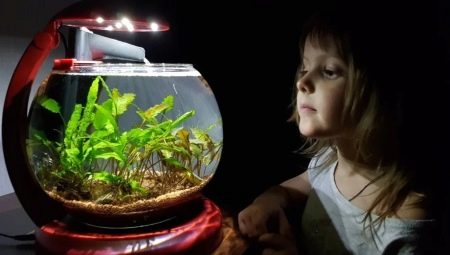
Spherical aquariums are distinguished by their sophistication and sophistication, do not take up much space and are easy to maintain. For them, special equipment is also selected for filtering the reservoir and enriching it with oxygen. Compact devices are suitable for spherical containers. How to choose a device for filtering water in a round aquarium and how to install and fix the device correctly? This will be discussed in this article.
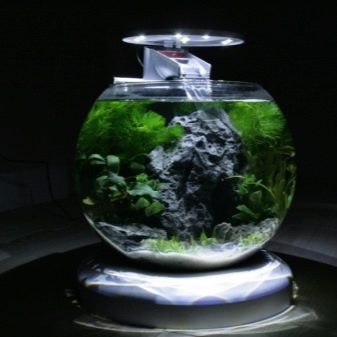
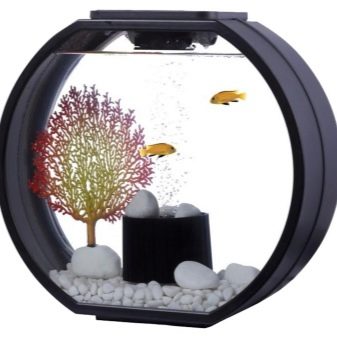
Varieties and features of filters
Owners of small ponds should pay attention to the bottom filter. The device is a compact device. Gravel is used as a filter material. The device looks like a flat pancake. The device is equipped with a pedestal pump. The speed of pumping water depends on the pump. The power of the pump is selected based on the volume of the aquarium. According to all standards, the filter should clean 5 times the volume of the container in 1 hour. For a round tank with a volume of 5 to 20 liters, use a filter with a minimum filtration rate.
The pump's operation is based on the circulation of water, due to which all fish waste and food residues are efficiently recycled.
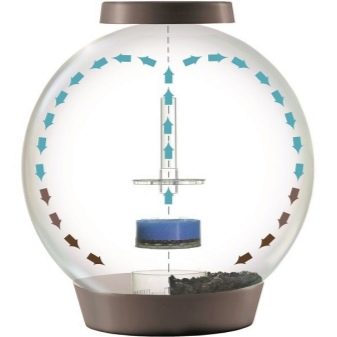
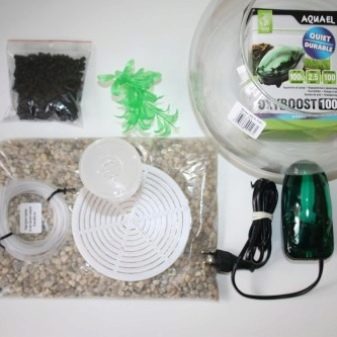
When using a bottom filter, do not fill up with sand or fine-grained soil. This can clog the cells that circulate the air. Each side of the issue has advantages and disadvantages. Of the advantages of bottom filters, the following aspects should be noted:
- silent process of work;
- uninterrupted circulation;
- you can disguise the device in algae or decorations;
- optimal price;
- high level mechanical and biological filtration;
- creation of the necessary microclimate in the reservoir;
- the liquid is purified in two stages;
- sand and soil do not sour.
The disadvantages of the devices include quick clogging and regular cleaning of the filter.
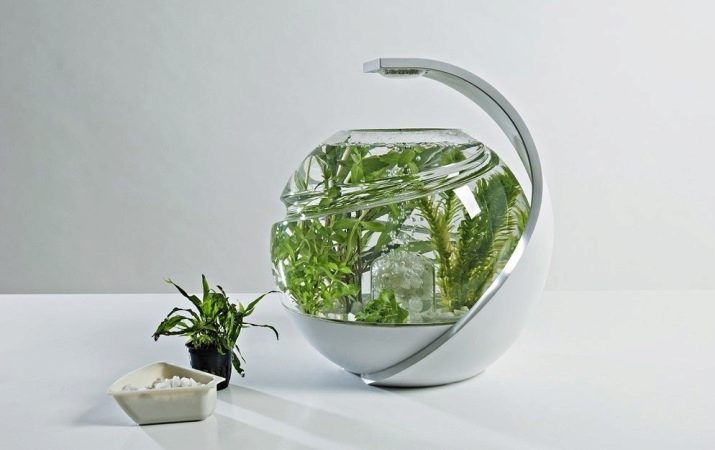
Also for small bodies of water there are hinged filters. This filter is perfect for round aquariums with a volume of 5 to 10 liters. Filters are of two types: with an internal and external type of attachment. The inner device is completely immersed in the reservoir, and the outer device is attached to the outer edges of the tank. For round aquariums, an external type of attachment is preferable. Some models of hinged filters equipped with LED backlight.
The process of work of filters-waterfalls creates a flow of water at a minimum speed. The flow is formed by the falling jet of water. A small current is enough to filter a small reservoir. Of the minuses, it is worth noting the inconvenient filling of the device with filtration materials.
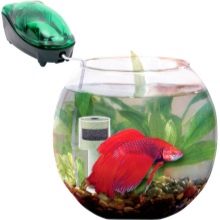
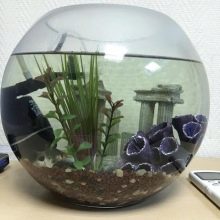
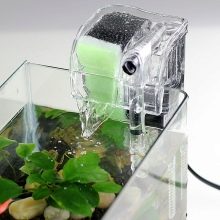
Glass filters are convenient due to the presence of a special compartment in the form of a glass, which can be filled with various filter media. When buying, it is worth checking the complete set for the presence of a flute nozzle, thanks to which it is possible to reduce the flow rate. It is also desirable that the nozzle of the device be regulated, this will help reduce the power of the water pressure. There are no downsides to glass filters. However, some manufacturers' devices make an unpleasant noise. When purchasing, it is recommended to immediately check the operation of the device.
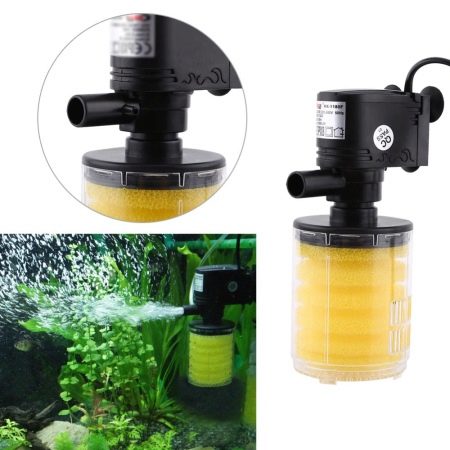
For mini ponds, you can use an air-lift filter that is installed inside the aquarium. The principle of operation is based on the movement of air under water. Air bubbles float to the surface and create pressure in the air outlet duct (tube). Under the influence of pressure, the water is purified by passing through the filter material. The disadvantage of the device is the noise from the murmur of water.
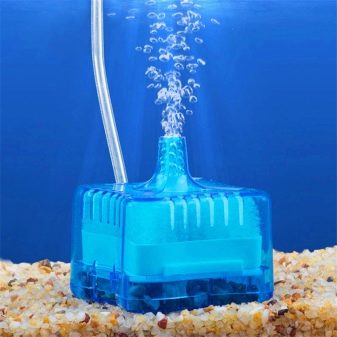
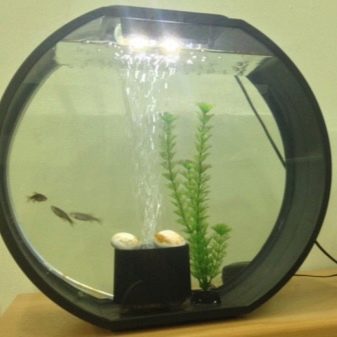
How to choose?
When choosing a filter for a round aquarium, you should pay attention to filtration methods. There are the following cleaning methods.
- Mechanical. The simplest filtering method. The device removes debris, small dirt, fish excrement and food residues from the pond. The design includes a motor, pump and sponge. The pump is pumping liquid. Then the water enters the sponge and is purified. This cleaning method is suitable for mini aquariums with a volume of 5-10 liters.
- Biological water purification. Purification of the reservoir is facilitated by special bacteria that inhabit the soil. The biological type of cleaning relieves the reservoir of toxic substances.
- Chemical cleaning removes odors and helps purify water from ammonia. This filtration has the highest degree of purification.
Also, when choosing a device, it is worth considering the filter power and performance. These parameters, as a rule, are indicated by the manufacturer on the packaging of the goods. The cost of the manufacturer plays an important role in the purchase of equipment. For a spherical container, it is worth choosing a device of an average price. In this case, it is possible to obtain the optimal ratio of cost and quality.
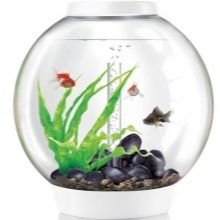
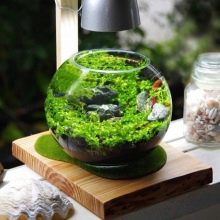
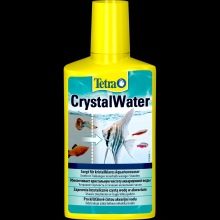
When buying filters for an aquarium it is also worth considering the type of attachment. For example, internal filters are suitable for illuminated ponds with a volume of 5-20 liters. Most often, the lighting on round aquariums is built-in and is located on the outside of the reservoir.
In order for the container to look aesthetically pleasing and not to spoil the appearance, choose internal devices that are installed inside the tank. However, there are compact external devices that are attached to the edges of the container and do not look so bulky. The best option is a hinged backlit filter, which performs several functions: illuminates the underwater space and provides high-quality filtration.
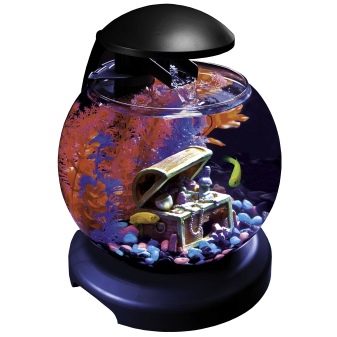
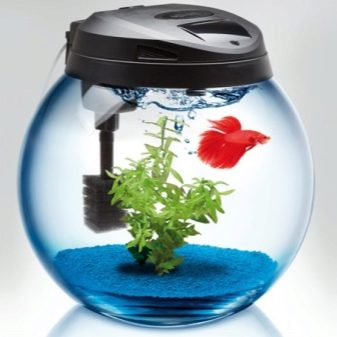
How to install?
The internal filter does not require much effort to install. Even a novice aquarist can handle this. It is enough to follow the step-by-step instructions.
- Before installation, the fish are moved to another tank.The filter is installed in a filled reservoir.
- The filter is secured with hooks, suction cups or Velcro, which are included in the package. The device is immersed in water, but a layer of water from 2 to 5 cm should remain above the filter. The device should not reach the bottom of the aquarium.
- After that, you should check the operation of the tube, which should come out to the surface for the free flow of purified water. To check, turn on the device and bring your hand to the tube outlet. Water should come out of it. This means that the device is working properly. Then you can populate the fish.
- Next, you need to adjust the fluid flow. It is better to set the filter in the middle position. Not all fish like strong currents. For a start, it is worth observing the inhabitants of the reservoir. If necessary, you can reduce or add the flow rate of the liquid.
To install an external filter, assembly is first required according to the instructions that come with the product. A special place is allocated for the filter. The location of the device should be 20 cm below the tank level. The device is placed under a pond. The inlet tubes and liquid outlet tubes are placed on opposite sides of the aquarium.
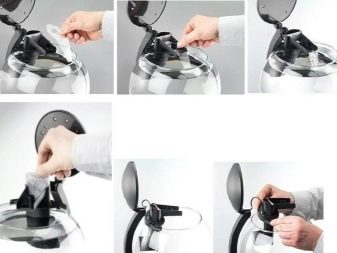
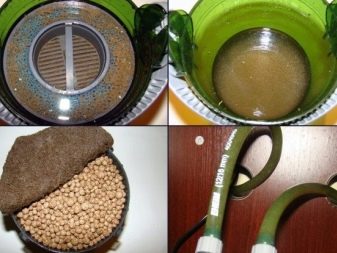
When installing the equipment, fill it with water by gravity. Connect and open the fluid intake hose. You should watch out for so that liquid does not flow out of the other hole. After water intake, the hose is closed. Next, turn off the tap of the hose that releases water, turn on the filter. When installing the bottom filter, liquid is removed from the reservoir and soil. Then you need to put the device so that it is located 2 cm above the bottom. After that, the soil is transferred back to the container.
See the following video for tips on how to reduce filter noise in your aquarium.








